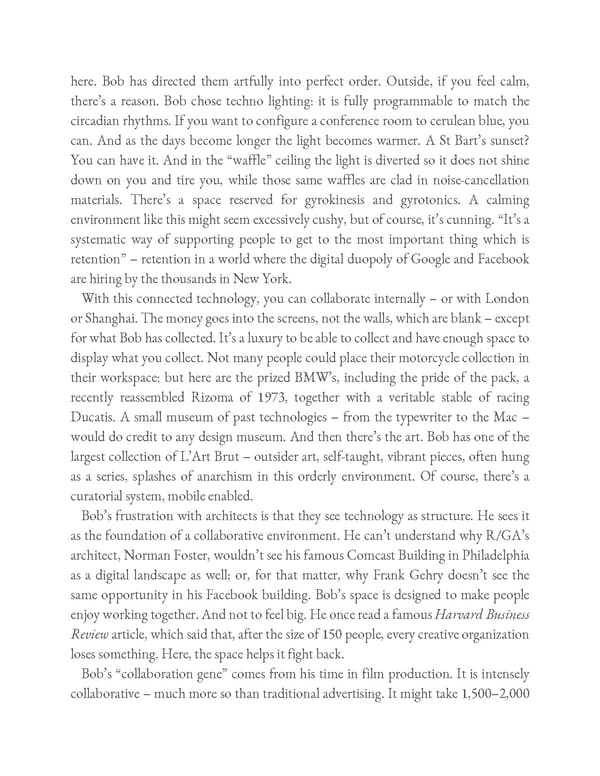here. Bob has directed them artfully into perfect order. Outside, if you feel calm, there’s a reason. Bob chose techno lighting: it is fully programmable to match the circadian rhythms. If you want to configure a conference room to cerulean blue, you can. And as the days become longer the light becomes warmer. A St Bart’s sunset? You can have it. And in the “waffle” ceiling the light is diverted so it does not shine down on you and tire you, while those same waffles are clad in noise-cancellation materials. There’s a space reserved for gyrokinesis and gyrotonics. A calming environment like this might seem excessively cushy, but of course, it’s cunning. “It’s a systematic way of supporting people to get to the most important thing which is retention” – retention in a world where the digital duopoly of Google and Facebook are hiring by the thousands in New York. With this connected technology, you can collaborate internally – or with London or Shanghai. The money goes into the screens, not the walls, which are blank – except for what Bob has collected. It’s a luxury to be able to collect and have enough space to display what you collect. Not many people could place their motorcycle collection in their workspace: but here are the prized BMW’s, including the pride of the pack, a recently reassembled Rizoma of 1973, together with a veritable stable of racing Ducatis. A small museum of past technologies – from the typewriter to the Mac – would do credit to any design museum. And then there’s the art. Bob has one of the largest collection of L’Art Brut – outsider art, self-taught, vibrant pieces, often hung as a series, splashes of anarchism in this orderly environment. Of course, there’s a curatorial system, mobile enabled. Bob’s frustration with architects is that they see technology as structure. He sees it as the foundation of a collaborative environment. He can’t understand why R/GA’s architect, Norman Foster, wouldn’t see his famous Comcast Building in Philadelphia as a digital landscape as well; or, for that matter, why Frank Gehry doesn’t see the same opportunity in his Facebook building. Bob’s space is designed to make people enjoy working together. And not to feel big. He once read a famous Harvard Business Review article, which said that, after the size of 150 people, every creative organization loses something. Here, the space helps it fight back. Bob’s “collaboration gene” comes from his time in film production. It is intensely collaborative – much more so than traditional advertising. It might take 1,500–2,000
 Ogilvy on Advertising in the Digital Age Page 360 Page 362
Ogilvy on Advertising in the Digital Age Page 360 Page 362